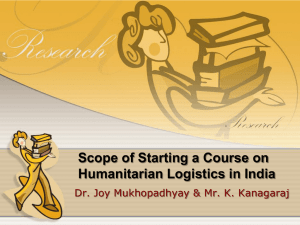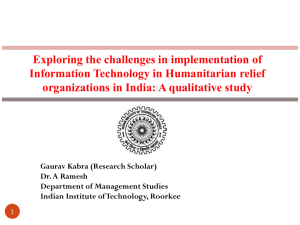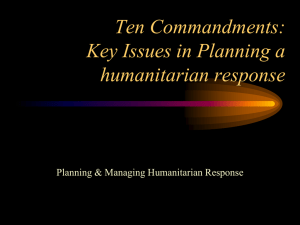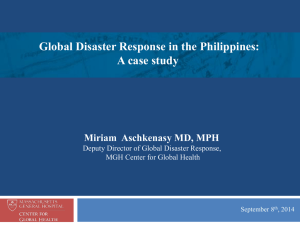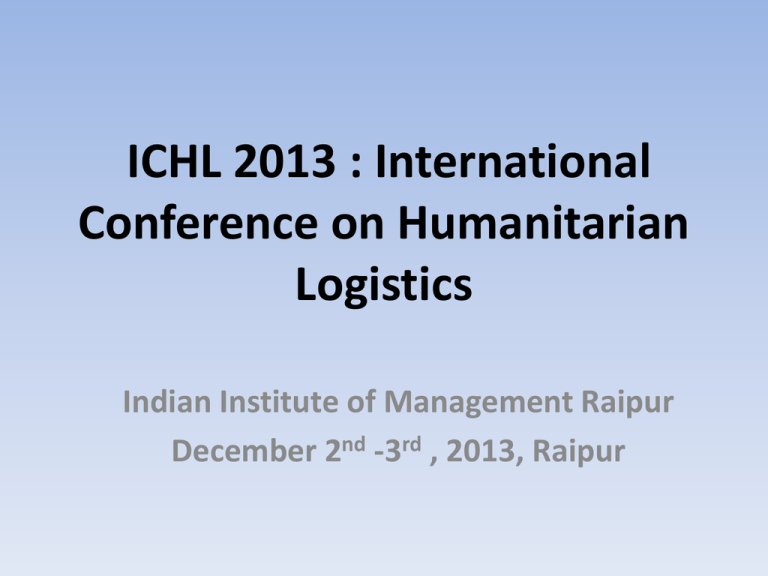
ICHL 2013 : International
Conference on Humanitarian
Logistics
Indian Institute of Management Raipur
December 2nd -3rd , 2013, Raipur
Humanitarian Logistics in Maoist
regions of North Eastern states of India
Author:
Mr. Guruprasad.T.S
Phd. Research Scholar
Karpagam University,
AGM – Corp planning, Elgi Equipments,
Coimbatore
Co-Author:
Dr. N. Panchanatham
HOD of Business Administration,
Annamalai University
Introduction
Humanitarian supply Chain delivers supplies,
relief items to support emergency response
operations.
It encompasses unique challenges:- Disrupted or poor road network
- Lack of communications
- Lack of security
- Harsh climatic conditions
- In-adequate staffing resources
Introduction
In India Humanitarian supply Chain could be
bit different due to its unique geo-climatic and
socio-economic conditions.
• India has 28 states and 7 Union Territories
• 58.6% Land mass is prone to Earthquake of
moderate to very high intensity.
• 12 % land is prone to flood and river erosion
• Out of 7516 Km coast line, 5700 km is prone
to cyclones and tsunamis.
Introduction
• Complex emergencies are usually man-made
• Natural Emergencies comes instantaneously
Introduction
Figure 1: Schema for classification of disastrous events
Background
Background
Name
Arunachal
Pradesh
Area
Official
(km2)
language(s)
Population
1,382,611
Assam
31,169,272
Manipur
2,721,756
Meghalaya
2,964,007
Mizoram
Nagaland
1,091,014
1,980,602
Sikkim
607,688
Tripura
3,671,032
Largest
Populati
Percentag
Literacy
city
Capital
on
e of Urban
(if not
Rate(%)
density
Population
capital)
83,743 English
Itanagar
Assamese,
78,550 Bengali;
Regional: Bodo
Dispur
22,347 Manipuri
English, Garo,
22,720 Hindi, Khasi,
Pnar,
21,081 Mizo
16,579 English
Nepali, Bhutia,
Gurung, Lepcha,
7,096 Limbu, Manggar,
Newari, Sherpa,
Sunwar, Tamang
10,492 Bengali, Tripuri
Sex
Ratio
17
66.95
20.8
920
397
73.18
12.9
954
Imphal
122
79.85
25.1
987
Shillong
132
75.48
19.6
986
Aizawl
Kohima Dimapur
52
119
91.58
80.11
49.6
17.2
975
931
Gangtok
86
82.2
11.1
889
Agartala
350
87.75
17.1
961
Guwahati
Background
• Has a complex security scenario
• Activities of various militant outfits with
diverse demands
• Repeated ethnically-motivated conflicts
persists
• Violence involving at-least ten different
ethnic groups.
Statistics of communal violence
Statistics of Communal violence
Data of Incidences
- At-least 50,000 people have been killed in conflicts
since 1947.
- Communal violence on 19.07.2012 in Kokrajhar,
Chirang and Dhubri Districts in which 99 lives were
lost and more than 4.85 lakh people were
displaced
- In 2011, the Maoists had blocked the national
highway for more than 120 days
- In Manipur the number of incidents of violence has
increased to 518
- Ambush on CRPF and seizure of supplies and arms
& ammunition
Objective
-
Study of current supply process in NER states
Challenges faced in Humanitarian logistics
Opportunities in Humanitarian logistics
Creating awareness and post disaster situation of
communal / social unrest
Supply process in NER states
- Government is providing relief aid by one
national highway.
- CRPF escort would be provided for
ensuring the safety.
- Transportation infrastructure is inadequate
and out-dated.
- Air transport is minimal.
Challenges in Humanitarian Logistics
The three biggest challenges:1. Logistics due to lack of infrastructure
2. Risk to the life of aid workers
3. Ambush security forces and loot supplies
while being transported
Challenges in Humanitarian Logistics
• CRPF escorts are defined by time and rules.
• There are incidents when police forces
refuse to accompany
• In these cases how do you reach the
required place at required time ?
Opportunities in Humanitarian logistics
• Translating models, theories and best practices
from the commercial world to humanitarian SCM
• Range of activities
•
•
•
•
•
•
•
Preparedness
Planning
Procurement
Transport
Warehousing
Tracking and Tracing
Customs and Clearance
Opportunities in Humanitarian logistics
Opportunities in Humanitarian logistics
• The preparation phase incorporates the strategies
to be implemented
• Planning to be carried out for efficient and cost
effective flow of materials
• The result would be successful operational
response.
Opportunities in Humanitarian logistics
Budget 2013:
Finance Minister stresses on waterways connectivity
for these states
Course of Brahmaputra
Opportunities in Humanitarian logistics
• Response phase where operations are instantly
implemented after a disaster occurs.
• 1800 km of navigable river routes.
• There are operational port locations in the states.
• Waterway connectivity between Mizoram and the
port of Akyab
• There is an inland container depot (ICD) at
Amingaon, Guwahati
An example of translating practices of commercial
world into humanitarian SCM is given below:• Shipment was bound for a 763-megawatt, gasbased power plant at Palatana near Agartala
• Involved movement of over-dimensional cargo
• Project logistics providers prefer to turn to
alternative routes to access these states.
• The cargo moved by sea to the Ashuganj River port
in Bangladesh, then overland to the project site
• Trans-shipment through neighboring Bangladesh
often provides a better solution.
Supply Chain Business Environment
Opportunities in Humanitarian logistics
• The reconstruction phase follows aftermath of a
disaster.
• It involves rehabilitation on a long-term
perspective.
• The objective of the reconstruction phase is cost
saving that can be achieved through leanness.
• Effectiveness ensures that we save time and lives.
• Efficiency ensures that we save costs which means
more lives can be saved.
Supply Chain performance measures
South African case study
South African case study
• Role players are involved in various activities at
different levels of Strategic-Tactical-Operational
continuum.
• Community awareness and sensitivity in SA society
that directly influenced the disaster management
activities.
• Role players had proactive and flexible engagement
with local communities, that resulted great
synergies.
• The role of media to create awareness
Creating awareness and post
disaster situation
In this phase a strategy should be adopted by
•
•
•
•
Central Government
State government
Local bodies
Public & private sector.
Creating awareness and post
disaster situation
• Has a forest cover of more than 66.1%
• Tourism can be competitive advantage
• It can generate jobs in the remotest corners
• Has only 3.4% of land for agricultural purposes
• Has observed high production of fruits, spices and
cashew in the recent past
• The topography is not favorable for the
movement of the products
Creating awareness and post
disaster situation
• Major constraints observed are
•
•
•
•
Infrastructure
procurement practices
marketing approaches
processing facilities
• It has enjoyed good trade relations with the
neighbouring countries
• Cross-border trade could be the important medium
• India could seek economic cooperation with ASEAN
and other neighbouring countries
Creating awareness and post
disaster situation
Category
High
High Middle
Middle
Human
Development
Index
Mizoram
Manipur,
Nagaland, Sikkim
Arunachal
Pradesh,
Meghalaya,
Tripura
Infrastructure Index
Lower Middle Assam
Low
Arunachal
Pradesh,
Assam,
Manipur,
Meghalaya, Mizoram,
Nagaland, Sikkim and
Tripura
Human Development
and Infrastructure
Index
Creating awareness and post
disaster situation
• How do we get over this man made disaster ?
• To build a Ram Rajya as envisioned by Gandhiji
• Manipur means “a jeweled land”
• Build back the Jewel of India as described by
Pt. Nehru.
References
•
•
•
•
•
•
•
•
•
•
Manipur Small Farmers’ Agri-business Consortium
Fritz Institute. http://www.fritzinstitute.org.
INSEAD Research Group in Humanitarian Operations.
http://www.insead.edu/humanitarian
University of Washington. Interdisciplinary Program on
Humanitarian Relief. http://depts.washington.edu/iphr
ReliefWeb. http://www.reliefweb.int
EM-DAT. International Disasters Data Database.
http://www.em-dat.net/
Journal of Humanitarian Assistance. http://www.jha.ac
Journal of transport and supply chain management Nov
2011
Globalization and North East India: Challenges and
Opportunities. Bhupendro Singh
Reference
• Annual Report of Ministry of Home affairs 2012.
• Humanitarian Logistics and Supply Chain Management A. Cozzolino, Humanitarian Logistics, SpringerBriefs in
Business, DOI: 10.1007/978-3-642-30186-5_2, _ The
Author(s) 2012
• http://www.fritzinstitute.org/pdfs/whitepaper/fromlogi
sticsto.pdf
• Supply Chains in Humanitarian Operations: Cases and
Analysis
• Thomas, A.S. (2003) Humanitarian Logistics: Enabling
Disaster Response. Fritz Institute.
Reference
• Sergio Ricardo Argollo da Costaa*, Vânia Barcellos
Gouvêa Camposb, Renata Albergaria de Mello
BandeirabUniversidade do Grande Rio, Rua Prof. José de
Souza Herdy, 1160 – 25 de Agosto, Duque de Caxias/RJ,
CEP 25071, BrasilInstituto Militar de Engenharia, Praça
General Tibúrcio, 80 – Praia Vermelha, Urca, Rio de
Janeiro/RJ, CEP 22290-270, Brasil
• A Peek into the Future of Humanitarian Logistics:
Forewarned Is Forearmed-Brian Majewski Global
Emergency Group, Kaustubh Anil Navangul Department
of Strategy and Logistics, BI Norwegian
• School of Management, Oslo, Norway, Ian
HeighEverywhere - Humanitarian Response and
Logistics Services, Portugal & Scotland, U.K.
Reference
• Humanitarian logistics: context and challenges by Lars
Gustavsson
• Identifying challenges and collaboration areas in
Humanitarian Logistics: A southern African perspective
– Charles MBohwa-Department of Quality and
Operations Management, University of Johannesburg,
Auckland
• Chapter 2 of Humanitarian Logistics and Supply Chain
Management Van Wassenhove (2006) p. 475
• EWGT2012 - Compendium of Papers
Thank you



